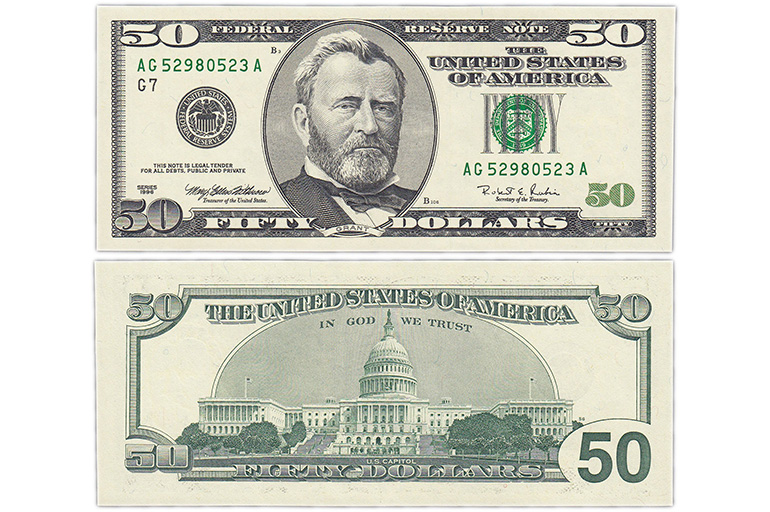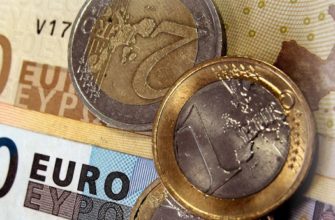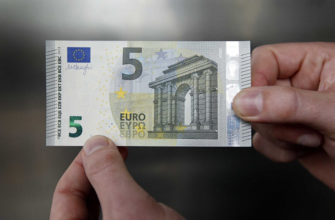50 dollars is the most popular banknote in those countries where this currency is used. For this reason, banknotes are often counterfeited. The risk of encountering a fake is higher in spontaneous markets, in small retail outlets and when concluding small (verbal) transactions. Counterfeiting 50 dollars, like other banknotes, is a criminal offense, so after finding a dubious banknote, you need to contact the nearest bank branch for verification.

What does a $50 banknote look like?
There are green and colored banknotes in active circulation. The former have been in circulation since 1996. The latter were issued later, in the 2000s. Sometimes there are banknotes of the old type, printed in the period from 1861 to 1995. However, such banknotes are not of financial, but of historical interest, therefore they are not used for payment.
On the front side of the current bills, regardless of the year of issue, Ulysses Grant is depicted. This is the 18th President of the United States, a political and military figure who was awarded the Congressional Gold Medal. The Capitol is depicted on the reverse side of the banknotes. This building houses the US Congress. Until 1935, sessions of the Supreme Court were held here.
Read also: what does 100 dollars look like
Greens
The 1996–2006 series features a light yellow backing. Red and blue protective fibers are embedded in it. Year of issue - 1996 or 2001.
.jpg)
There is a watermark and a special security thread on the surface. For the production of banknotes, paper with a diagonal or parallel structure was used. This was expressed in the play of light and colors: if you place a bill under a special filter, you can see reflections in the form of rows.
colored
The new series of banknotes is called NexGen. They have been in circulation since 2004. The backing of banknotes has become non-uniform, it combines blue, purple and yellow shades. A watermark was applied to the surface.
The number of red and blue inclusions increased by 2–4 times. A polymeric security thread with text passes through the paper.
What to look for when checking for authenticity
When checking banknotes yourself, you should consider the following details:
- substrate color;
- shade and quality of ink;
- inscriptions;
- watermark;
- security thread;
- printing;
- serial number;
- overall design.
.jpg)
It is not difficult to identify gross fakes: their paper is of poor quality, it may resemble glossy, the ink is uneven, sometimes deformed or imprinted on fingers with strong physical impact. Such fakes are rarely used, more often outside countries in which the dollar is the main currency. However, in some cases, scammers try to pay them off with gullible citizens, or simply plant them for fun. To identify high-quality fakes, you will have to use additional equipment.
Read also: 500 ruble bill
In rare cases, scammers use joke banknotes to deceive or draw jokes, sometimes very reminiscent of the original. In order not to confuse them with genuine ones, it is enough to pay attention to the inscriptions. Numbers are printed in the corners of the banknote, which indicate the denomination. In this case, this number is 50. At the bottom, the value is duplicated in letters - fifty dollars. The Federal Reserve Note must be on the top of the bill. Below the president's portrait are the notes GRANT and The United States of America.
| Common feature | Original | Fake |
| paper texture | The paper is made of linen and cotton using a secret technology, does not lose strength, is thin. It is impossible to find such materials in the public domain. Embossed print. The clothes of the person depicted in the portrait are slightly convex. | Standard paper, purchased at an office supply store. The print is flat, there are no bulges. Banknotes are thicker than standard. |
| Level of detail | Banknotes are printed using a secret technology that is difficult to reproduce exactly. There are many small details on banknotes, such as colored fibers. They are bound with paper. | Fakes do not copy the original well enough. The details are small and blurry, so they cannot be repeated without special equipment. If there are colored fibers on the bill, they are printed on top of the paper, and are not part of it. The border is blurred, may be intermittent. |
| Security features | A security thread is sewn to the left of the Federal Reserve Seal. When exposed to light, the inscription USA can be found on it. The symbols are visible on both sides of the bill. The watermark is embedded to the right of the portrait. He repeats the image of a person. The ink partially changes color. | Microprinting is blurry or missing. The ink does not change color. The security thread copies the original only partially. The watermark is blurry. |
Ink color
The nominal designation in the lower right corner is made with a special optically variable paint. For this reason, the color of the mark depends on the slope of the bill. On old banknotes, the hue changes from black to green, on new banknotes, from yellowish copper to green.
.jpg)
Watermark
The security mark is barely visible. This is an almost colorless small portrait of Ulysses Grant. It is located on the right side of the banknote, next to the seal. To make it easier for you to distinguish a fake from the original, carefully inspect the genuine bill. On counterfeit banknotes, the watermark is blurred or, on the contrary, consists of thick outlines.
Some scammers cannot copy it, so they do not put it on the surface at all.
Security thread
The polymer strip is embedded in the paper. It cannot be separated from the banknote without damaging it. The thread is embossed with a metallic USA mark, a denomination designation and a simplified image of the US flag. The text is duplicated upside down, so it can be read from either side. Under UV exposure, the protective tape glows slightly yellow. It looks the same on old and new banknotes.
.jpg)
microprinting
The seal is so small that it is almost impossible to see it with the naked eye. It is also difficult to counterfeit, so counterfeiters often neglect this element, although high quality fakes are sometimes found. Microprinting is inscriptions. To the left of the portrait are repeated marks "50" and USA. Near the collar and beard of Ulysses Grant, one can find the inscription "The United States of America".
Serial numbers
The number is a combination of 11 numbers and letters. It is located on the front side under the seal on the right. Compared to the rest of the $50 bill, the serial number is slightly offset to the edge of the bill. The combination with the symbol is unique for each sample. Thanks to it, law enforcement agencies identify banknotes, and regulatory organizations monitor the quality of printing.

The first letter of the serial number indicates the year of manufacture. For example, for 1996, this is A. The second letter and the lower part of the number correspond to the bank that issued the banknote into circulation. Each county has its own combinations.
For example, for New York it is B2. If you see B3 or A10 in the serial number, you have a fake.
Additional security designs
To complicate the creation of fakes, bills are given relief. First of all, this affects the elements of the portrait. For banknotes, special paper is produced, which is no longer used in any area of life. When bent, it emits a characteristic crunch. The composition of the paper is close to the fabric, therefore it is thinner and stronger than classic sheets. When examining banknotes under a magnifying glass, you can see intertwining fibers that look like threads.
Ways to check dollar bills
High-quality fakes are difficult to distinguish from the original. Some scammers have learned to partially copy the texture of paper and security signs. In such cases, ultraviolet and infrared radiation has to be used to detect fakes.
Under ultraviolet
Genuine banknotes do not glow under the rays. Only the security thread and special fibers that are sewn into the structure of the paper luminesce. Fakes most often glow entirely, because other materials are used in their manufacture. The protective tape may not luminesce or give off a different color, such as purple. The thread should glow on both sides.
.jpg)
With infrared light
Part of the image on the banknotes is applied with special inks that absorb infrared radiation. For this reason, when examining original banknotes through the detector, empty stripes are visible. To distinguish a bill from a fake, you should familiarize yourself with the samples. A slight shift of empty vertical bands (by 2–3 mm) is considered normal.
Banknotes issued in 1996 cannot be checked using this method. Special inks were not used in their manufacture, therefore, when viewed through the detector, the entire image is visible. The year of issue is on the front side on the left.
What to do if you get a fake $50
If you suspect that you have counterfeit money, do not try to pay with it. Such actions are regarded as fraud or complicity in criminal schemes. In Russia, for committing such a crime, you can be imprisoned for up to 15 years.
First of all, if you find a counterfeit bill, contact any bank. Take your passport with you. Explain the situation to the consultant, ask him to conduct an audit and fill out an application for an examination.
If your suspicions are confirmed, contact the police. Tell us where you supposedly could get the banknote. Keep calm and don't be afraid. In this situation, you are the victim. Consider all versions: fakes can be not only in the market or in a stall, but also in an ATM. Thanks to you, law enforcement officers can detect counterfeiters and protect other citizens.







-335x220.jpg)







Good article. I would like to draw the reader's attention to the following points: 1. Where can you get counterfeit money (if you do not print it yourself)? ATM? Bank exchange? Did you change at the shop? Unlikely, more likely not possible. More often than not, just as surrender on the market. Hence the rule: When calculating in cash, change should not be, or it should be minimal. 2. Use the non-cash form of payment (plastic) to the maximum. 3. When receiving cash in the exchange office, ask to issue the ordered amount in familiar banknotes.
Interestingly, on the one hand, the counterfeiting market is developing, as people use contactless payment methods and are watched less. On the other hand, there are more and more fakes ....
There are many signs, the most important thing is to know how to distinguish them from each other. I think the best thing to do is a professional. In many respects, it is now possible to do so. Thank you for the interesting article which will be useful to many.
во молодцы фальшиво монетчики сколько их ловят а почему-то меньше их не становится и с каждым годом все трудней и трудней отличить оригинал от подделок